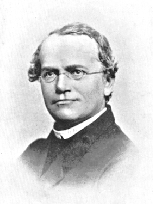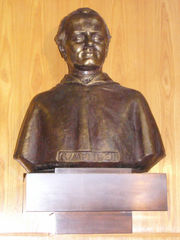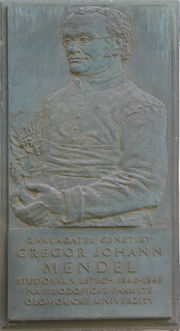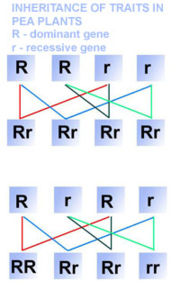Gregor Mendel
2007 Schools Wikipedia Selection. Related subjects: Human Scientists
 |
|
| Born | July 20, 1822 Heinzendorf, Silesia |
|---|---|
| Died | January 6, 1884 Brno, Moravia |
| Field | Genetics |
| Institution | Abbey of St. Thomas in Brno |
| Alma Mater | University of Vienna |
| Known for | "Discovering" modern genetics |
| Religion | Roman Catholic |
Gregor Johann Mendel ( July 20, 1822 – January 6, 1884) was an Augustinian abbot who is often called the "father of modern genetics" for his study of the inheritance of traits in pea plants. Mendel showed that the inheritance of traits follows particular laws, which were later named after him. The significance of Mendel's work was not recognized until the turn of the 20th century. Its rediscovery prompted the foundation of genetics.
Biography
Mendel was born on July 20, 1822 to a German-speaking family in Heinzendorf, Silesia, then part of the Austrian Empire (now Hynčice in the Czech Republic), and was baptized 2 days later. During his childhood Mendel worked as a gardener, and as a young man attended the Philosophical Institute in Olmütz Olomouc. In 1843 he entered the Augustinian Abbey of St. Thomas in Brno, (Brünn). Born Johann Mendel, he took the name Gregor upon entering monastic life. In 1847 he was ordained as a priest. In 1851 he was sent to the University of Vienna to study, returning to his abbey in 1853 as a teacher, principally of physics.
Gregor Mendel, who is known as the "father of modern genetics", was inspired by both his professors at university and his colleagues at the monastery to study variation in plants. He commenced his study in his monastery's experimental garden. Between 1856 and 1863 Mendel cultivated and tested some 28,000 pea plants. His experiments brought forth two generalizations which later became known as Mendel's Laws of Inheritance.
Mendel read his paper, " Experiments on Plant Hybridization", at two meetings of the Natural History Society of Brünn in Moravia in 1865. When Mendel's paper was published in 1866 in Proceedings of the Natural History Society of Brunn, it had little impact and was cited about three times over the next thirty-five years.
Elevated as abbot in 1868, his scientific work largely ended as Mendel became consumed with his increased administrative responsibilities, especially a dispute with the civil government over their attempt to impose special taxes on religious institutions.
Mendel died on January 6, 1884, in Brünn ( Brno), Austria-Hungary (now Czech Republic), from chronic nephritis.
Rediscovery of Mendel's work
It was not until the early 20th century that the importance of his ideas was realized. In 1900, his work was rediscovered by Hugo de Vries and Carl Correns. Though Erich von Tschermak was originally also credited with rediscovery, this is no longer accepted as he did not understand Mendel's laws. Mendel's results were quickly replicated, and genetic linkage quickly worked out. Biologists flocked to the theory, as while it was not yet applicable to many phenomena, it sought to give a genotypic understanding of heredity which they felt was lacking in previous studies of heredity which focused on phenotypic approaches. Most prominent of these latter approaches was the biometric school of Karl Pearson and W.F.R. Weldon, which was based heavily on statistical studies of phenotype variation. The strongest opposition to this school came from William Bateson, who perhaps did the most in the early days of publicizing the benefits of Mendel's theory (the word "genetics", and much of the discipline's other terminology, originated with Bateson). This debate between the biometricians and the Mendelians was extremely vigorous in the first two decades of the twentieth century, with the biometricians claiming statistical and mathematical rigor, while the Mendelians claimed a better understanding of biology. In the end, the two approaches were combined as the modern synthesis of evolutionary biology, especially by work conducted by Ronald Fisher in 1918.
His experimental results have later been the object of considerable dispute. The renowned statistician R. A. Fisher analyzed the results of the F1 (first filial) ratio and found them to be implausibly close to the exact ratio of 3 to 1. Only a few would accuse Mendel of scientific malpractice or call it a scientific fraud — reproduction of his experiments has demonstrated the accuracy of his hypothesis — however, the results have continued to be a mystery for many, though it is often cited as an example of confirmation bias. This might arise if he detected an approximate 3 to 1 ratio early in his experiments with a small sample size, and continued collecting more data until the results conformed more nearly to an exact ratio . It is sometimes suggested that he may have censored his results, and that his seven traits each occur on a separate chromosome pair, an extremely unlikely occurrence if they were chosen at random. In fact, the genes Mendel studied occurred in only four linkage groups, and only one gene pair (out of 21 possible) is close enough to show segregation distortion; this is not a pair that Mendel studied.
The standard botanical author abbreviation Mendel is applied to species he described.
Mendel, Darwin and Galton

Mendel lived around the same time as the British naturalist Charles Darwin ( 1809 – 1882) and many have fantasized about a historical evolutionary synthesis of Darwinian natural selection and Mendelian genetics during their lifetimes. Mendel had read a German translation of Darwin's Origin (as evidenced by underlined passages in the copy in his monastery), after completing his experiments but before publishing his paper. Some passages in Mendel's paper are Darwinian in character, evidence that The Origin of Species influenced Mendel's writing. Darwin did not have a copy of Mendel's paper, but he did have a book by Focke with references to it. The leading expert in heredity at this time was Darwin's half-cousin Francis Galton who had mathematical skills that Darwin lacked and may have been able to understand the paper had he seen it. In any event, the modern evolutionary synthesis did not start until the 1920s, by which time statistics had become advanced enough to cope with genetics and evolution.
The historian of evolution, Peter J. Bowler, has argued that it would not matter much if Darwin or even Galton had read Mendel, because not even Mendel was attempting to make the argument that his observed ratios were universal (he considered them to be a special case). In any case, Darwin and most of his contemporaries considered heredity to be a question best solved through observation of cell development— embryology in particular—and would not likely have been in a position to appreciate in-roads between evolution and what would become genetics (and indeed they were not appreciated until the early 20th century).
Possible Exception to his laws of Inheritance
In 2005, scientists at Purdue University discovered in arabidopsis an alternative to previously known mechanisms of DNA repair, which one scientist called a "parallel path of inheritance". It was observed in mutations of the HOTHEAD gene. Plants mutant in this gene exhibit organ fusion, and pollen can germinate on all plant surfaces, not just the stigma. After spending over a year eliminating simpler explanations, it was indicated that the plants "cached" versions of their ancestors' genetic code going back at least four generations, and used these records as templates to correct the HOTHEAD mutation and other Single nucleotide polymorphisms. The initial hypothesis proposed that the record may be RNA-based Since then, alternative models have been proposed which would explain the phenotype without requiring a new model of inheritance More recently the whole phenomenon is being challenged as being a simple artifact of pollen contamination. "When Jacobsen took great pains to isolate the plants, he couldn't reproduce the [reversion] phenomenon," notes Steven Henikoff. In response to the new finding, Lolle and Pruitt agree that Peng et al.'s did observe cross-pollination but note that some of their own data, such as double reversions of both mutant genes to the regular form, cannot be explained by cross pollination.
Trivia
- The lunar crater Mendel and asteroid 3313 Mendel were named in his honour.

